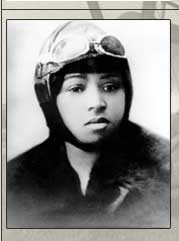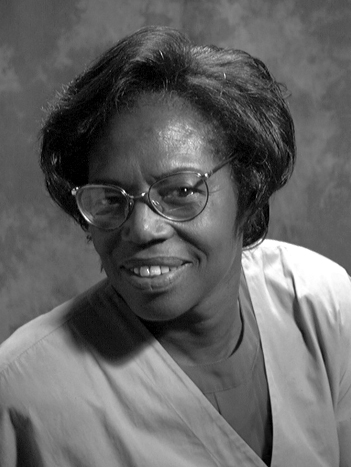Bessie ColemanField: Aviation
Why she’s on our list: Coleman was the first black woman aviator. She received an international pilot’s license in 1921 in France due to the Jim Crow laws of the United States.
Bessie Coleman was born into a large family in Atlanta, Texas, on January 26, 1892, the tenth of thirteen children.
In 1901, Bessie’s happy life took a dramatic hit.George Coleman left his family.He had become fed up with the racial barriers that existed in Waxahachie and all across the state of Texas.He returned to Oklahoma, or Indian Territory as it was called then, to find better opportunities.Unable to convince his wife and children to go with him, he left with a heavy heart.Soon after Bessie's father left, her remaining older brothers also left home, leaving Susan Coleman with four girls under the age of nine.Within days of George’s departure, Susan found work as a cook/housekeeper for Mr. And Mrs. Elwin Jones.They were generous employers who allowed Susan to continue to live at home and who would give food and handed-down clothing to the Coleman girls.While her mother worked at the Jones residence, Bessie took over as surrogate mother and housekeeper at the Coleman home on Mustang Creek.Every year Bessie’s routine of school, chores, and church was shattered by the cotton harvest.Each man, woman, boy and girl was needed to pick the cotton, so the Coleman family worked together in the fields during the harvest. At the age of twelve Bessie was accepted into the Missionary Baptist Church.Bessie completed all eight grades of her one-room school, yearning for more.Bessie saved her money and then in 1910 took her savings and enrolled in the Colored Agricultural and Normal University in Langston, Oklahoma.Bessie completed only one term before she ran out of money and was forced to return to Waxahachie.She continued her former life working as a laundress in the small Texas town.In 1915, at the age of twenty-three, she set out to stay with her brother, Walter, in Chicago while she looked for work.All she wanted was a chance to “amount to something”.
By 1918, Bessie's mother Susan and her three younger sisters, Georgie, Elois and Nilus, had joined Bessie and her brothers in Chicago. Walter and John had served in France during World War I and returned safely, only to witness 1919 Chicago battered by the worst race riot in history. By then, Bessie had been in Chicago for nearly five years. During that time, she had moved north, learned a trade and supported herself, watched her brothers return from war and survived a race riot. As the summer of her 27th year ended, she was still looking for a way to "amount to something." Taking her cue from brother John's teasing remarks about French women flying and having careers, Bessie decided she would become a flier.
Having secured funding from several sources and received a passport with English and French visas, Bessie departed for France in November of 1920. She completed in seven months, a ten month course at the Ecole d'Aviation des Freres Caudon at Le Crotoy in the Somme. Learning to fly in a French Nieuport Type 82, Bessie's schooling included "tail spins, banking and looping the loop." She received her license from the renowned Federation Aeronautique Internationale(FAI) on June 15, 1921. Her birthplace was listed as Atlanta, Texas, but her age was listed as 25(the figure she had given passport authorities in Chicago) rather than 29 that she actually was. The license did not indicate that Bessie was the first black woman to ever earn a license from the prestigious FAI nor that she was the only woman of the sixty-two candidates to earn FAI licenses during that six-month period.
In the time between her 1922 flying debut in New York and her 1925 Texas debut, Bessie never lost sight of her goal of opening a school for aviators. She flirted briefly with a movie career, traveled to California to earn money for a plane of her own, crashed that plane once she bought it and then returned to Chicago to formulate a new plan. It was another two years before she finally succeeded in lining up a series of lectures and exhibition flights in Texas. Once there, she defied not only racial barriers but gender barriers as well. She appeared in San Antonio, Richmond, Waxahachie, Wharton,Dallas and numerous unreported small towns and fields. At Love Field in Dallas, she made a down payment on a plane from the Curtiss Southwestern Airplane and Motor Company, probably an old Jenny(JN-4 with an OX-5 engine).
Following a brief return to Chicago, Bessie left for a series of lectures in black theaters in Georgia and Florida. After two months in Florida, she opened a beauty shop in Orlando to hasten her accumulation of funds to start the long awaited aviation school. Using borrowed planes Bessie continued exhibition flying and occasional parachute jumping. As she had often done in other U.S. locations, Bessie refused to perform unless the audiences were desegregated and everyone attending used the same gates. With the patronage of a wealthy businessman, Bessie made the final payment on her plane in Dallas and arranged to have it flown to Jacksonville for her next engagement scheduled for May 1, 1926.
At the end of April in 1926, Bessie's Jenny arrived in Jacksonville. On the evening of April 30th, she and her mechanic took the plane up for a test flight. Once aloft, the plane malfunctioned and the mechanic, who was piloting the plane from the front seat, lost control of the plane. Bessie fell from the open cockpit several hundred feet to her death.
Five thousand mourners attended a memorial service for Bessie before her body traveled by train from Orlando to Chicago. An estimated ten thousand people filed past Bessie's coffin to pay their last respects. Thousands more attended the funeral of that little girl from Texas who dreamt of a better life as she picked cotton at the dawn of the 20th century. Only after her death did Bessie receive the recognition that she deserved.
Her dream of a flying school for African American's became a reality when William J. Powell established the Bessie Coleman Aero Club in Los Angeles, California in 1929. As a result of being affiliated, educated or inspired directly or indirectly, by the
Bessie Coleman Aero Club, flyers like the Five Blackbirds, the Flying Hobos(James Banning and Thomas Allen), the Tuskegee Airmen, Cornelius Coffey, John Robison, Willa Brown and Harold Hurd continued to make Bessie Coleman's dream a reality.
In 1931, the Challenger Pilots' Association of Chicago began an annual flyover at Chicago's Lincoln Cemetery to honor Coleman. Three years later, William J. Powell dedicated his book,
Black Wings, to Coleman's memory. More than 45 years later, in 1977, women pilots in the Chicago area established the Bessie Coleman Aviators Club.
The 1990s brought long awaited accolades:
Mayor Richard Daley redesignated Old Mannheim Road at O'Hare Airport as Bessie Coleman Drive in 1990; May 2, 1992 was declared Bessie Coleman Day in Chicago; and in 1995, the U. S. Postal Service issued a Bessie Coleman stamp commemorating "her singular accomplishment in becoming the world's first African American pilot and, by definition , an American legend."













